Here’s my detailed analysis after almost 5 years of generating solar power in the West End.
By Matt Power
If you own a building in Portland, you may be thinking about the pros and cons of installing solar panels. I hope my experience will convince you that despite the initial hassles, the changing landscape of energy costs in Maine makes it worth the money and effort.
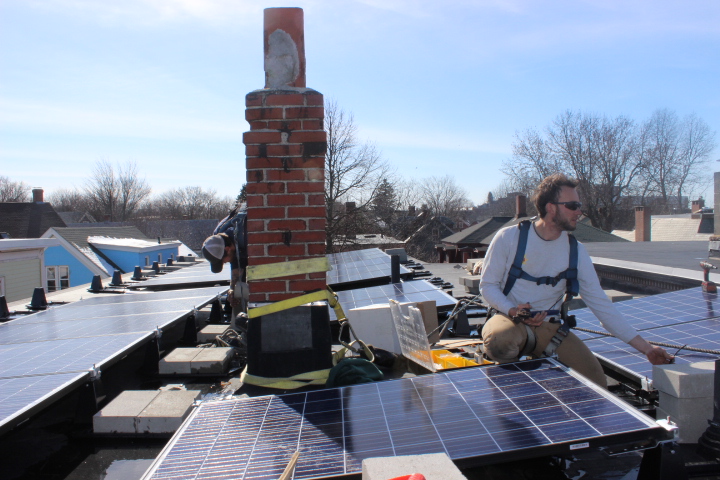
Back in 2017, I began talking with ReVision Energy about reducing by CO2 footprint on my 3-unit building on Dow Street. We decided that for my flat roof, a 7 kilowatt system would be about right, with a 6 kilowatt inverter, and no battery storage.
At the time of my installation, inverters with automatic switchover to battery power were not readily available. New systems, however, can include a dual function inverter with automatic switchover to battery power in an outage. That makes adding battery storage now or later much more affordable. Based on what CMP and others are telling us about natural gas shortages and grid reliability, backup storage may become more urgent, as soon as this winter.
Over the long haul, however, we need to start thinking about upgrading all buildings to net zero performance, ditching natural gas and converting to full electric equipment.
Some Assembly Required
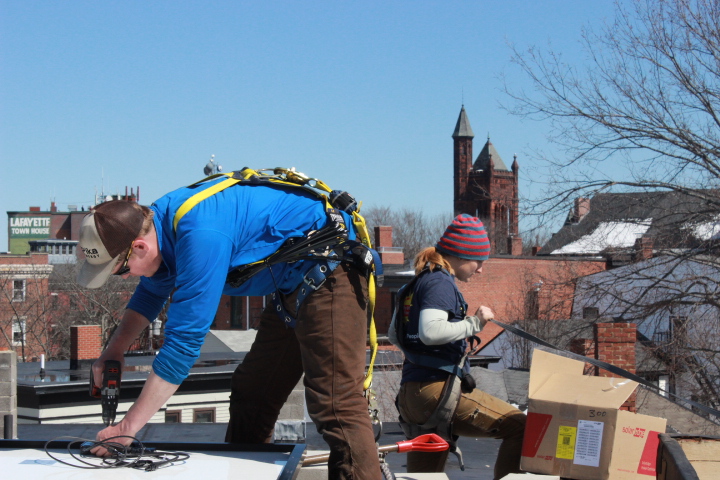
The total cost to install my solar system was about $19,000. After the 30 percent federal tax credit, my net total cost was closer to $13,000. Part of what drove that price up, however, were the challenges of working in the tight quarters of the West End on a multifamily building.
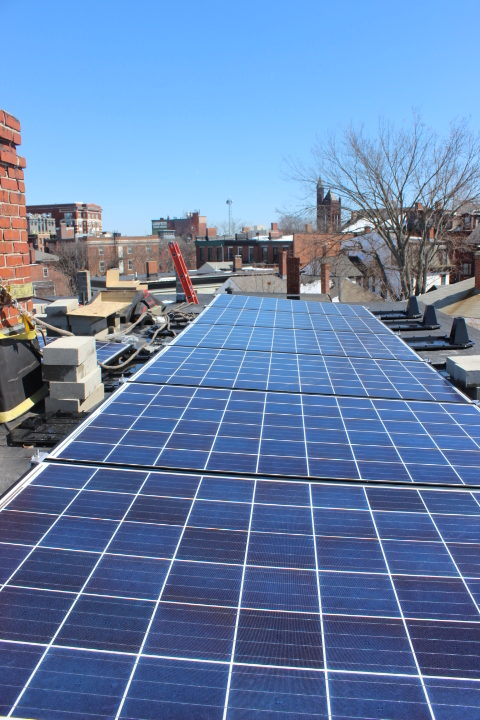
First, I had to have an engineer inspect and approve the strength of my flat roof. Fortunately, the 100-year-old wood-framed building was overbuilt, so no additional framing was needed. The roof has an EPDM (rubber) roof membrane, so the installer recommended that we ballast the panels, rather than penetrating the rubber membrane with fasteners.
That raised a big problem, however. ReVision could not maneuver a crane close enough to the building to lift the 119 concrete blocks of ballast onto the roof—not to mention the panels and other gear. I cringingly agreed to move the blocks, if they would handle the rest. With the help of my wife and two hired hands I found on Craigslist, we lugged the blocks up four flights of stairs over one afternoon. It took us a couple days to recover.
ReVision’s crews handled the rest of the job, including permitting and haggling with the Historic office about sightlines. They also installed electric heat pumps in each of the three floors of the building, all tied to the solar-fed panel. My plan was to try to use the solar energy to reduce my overall dependence on natural gas in the building.
Performance and Payback
Here’s what you really want to know: Was the solar install worth the money and effort? If you had asked me two years ago, I might have said no. But a lot has changed.
First, the price of natural gas keeps rising, with no end in sight. Second, climate change compels us to act. Third, the electric grid is tenuous, the price of power volatile.
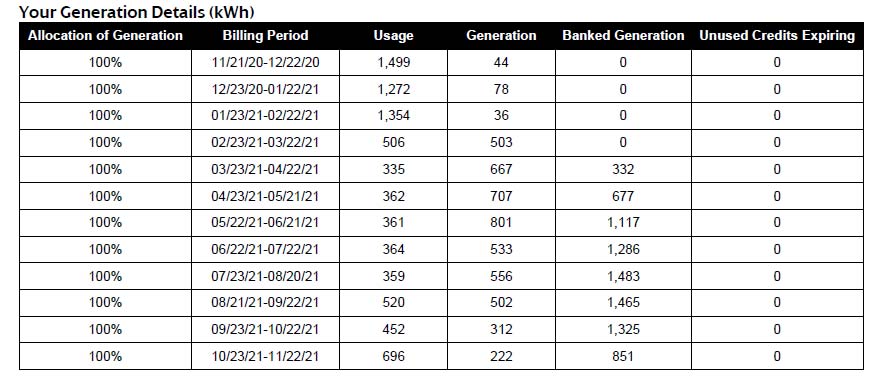
As you can see from the table, we use all of the energy we produce, averaging 670 kWh (kilowatt hours) of demand each month. Keep in mind that this usage includes all of the mini splits (for multiple floors) plus our personal electric use for one apartment. We’re able to cool the entire building in the summer without tapping out all of our “banked” credits. Heating with mini splits, however, is much less efficient, so we quickly use all of our banked hours. And our solar performance drops to almost zero for two or three months when snow covers the panels. We decided climbing up to scrape them off after each storm wasn’t worth the value added.
Until recently, Portland has had very inexpensive electricity, about 7 cents per kWh. We produced about 433 kWh of energy per month in 2020, so if you do the math, we’ve only been paying back about $303 per year of our solar investment. That’s not great. Portland’s (CMP) utility rates, however, are expected to go up about 12 percent this year, so our payback will shorten accordingly. Every time energy prices rise, our solar panels become more valuable assets.
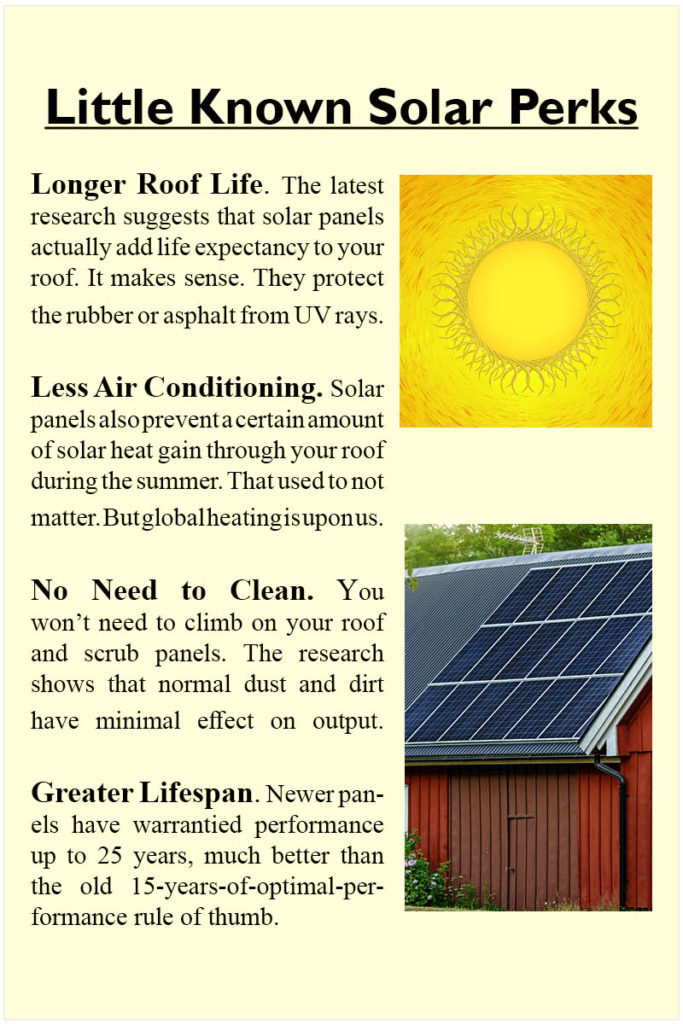
The Storage Decision
Adding batteries to your solar power array will likely double the cost of your system. The most affordable option is to tie your power production to CMP’s grid. You basically trade the power you make for an equal number of credits from the electric utility. This will result in an extra meter on your building that basically runs backwards.
Sure, batteries offer some piece of mind. They can keep things running during outages, but they require a lot of resources to produce, start to lose their value the moment you purchase them, and are rarely needed in urban areas, where power outages tend to get repaired more quickly. That being said, we have just been warned that New England may face “rolling blackouts” this winter.
Here’s a Yankee option:
Set up a small battery backup for now, just enough to provide you with power for key systems, such as running your gas boiler in the building during an ice storm. I did the calculation for my building, by testing the electricity required by my boiler, with all three pumps running to move the heated liquid to each floor. I tested their power draw using a Kill-A-Watt device that you just plug in to an outlet. The Portland Public Library used to loan them out, and may still. Another way to do this is with a Wemo Insight that sends a power reading to your smartphone.
In my case, I need only 800 watts to keep the heat on in my building. The turnkey way to set up a backup would be to have my installer add a small, commercial battery pack to the dual function solar inverter. Instead, I plan to do a homemade version using a 1200-watt power inverter/charger that has an automatic transfer switch. You can buy one on Ebay for about $400, hook it up to four 12-volt batteries, plug it into a circuit on the same panel as your solar feed, and you could run your gas boiler for several hours in an outage.
The Bottom Line
Based on how much CO2 we have kept out of the air with our solar system since installation, my wife and I now live a carbon neutral lifestyle in downtown Portland (being vegetarian helps).
Our long term goal is to improve the performance of our leaky building so that solar power can handle most of the energy load for the whole structure. As a very rough benchmark, right now we produce enough energy to fully heat, cool and electrify one of the three 1,100 sq. ft. apartments. We also plan to get completely off natural gas and switch to all-electric living. We’ve already removed all gas kitchen appliances in the building.
If you have specific questions about pros and cons of installing solar power on the West End, feel free to email me at the address below. My goal in writing this article is to inspire more solar in town, but with realistic expectations.
About the Author
Matt Power is an award-winning journalist based in Portland, who covers and encourages sustainable building practices. You can reach him at matt.power at greenbuildermedia.com.






1 Comments
Anti-Harassment Police
Are you the Matt Power harassing someone on Nextdoor for fixing up a home and renting it out at a market rate? Not cool man. It’s not that person’s fault the housing stock isn’t increasing enough in a place where people from all over the country are flocking to, and therefore driving up prices for everyone. I get the point you’re trying to make but aim your energy and passion in a direction that will actually make a difference, please.